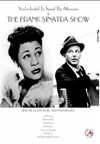
In the late 1950s, at arguably the apogee of his cultural influence and artistic powers, the fates (in the form of Timex’s sponsorship) rewarded Frank Sinatra with a set of network television specials. The shows, classic variety shows of the old mode, featured Ol’ Blue Eyes and a variety of musical guests. In December 1959, Sinatra’s show played host to another jazz singer at the height of her career: Ella Fitzgerald.
Both singers had benefitted immeasurably from the skills of Nelson Riddle, who had spearheaded Sinatra’s return to popularity upon his transition to Capitol Records after a career slump and had arranged and conducted Sinatra’s famous “concept” albums In the Wee Small Hours of the Morning and Songs for Swingin’ Lovers, as well as dozens of singles. Riddle had also been the musical genius behind Ella’s series of explorations of American popular songs, the Songbooks. With Riddle in the orchestral pit, the show sounds like one of those Capitol recordings. This is as good as pop music got in the middle of the century.
The format of the show was simple: a little introductory song and dance—here in the form of complaints for the bad weather in Palm Springs, where the show was being shot—followed by dialog between Sinatra and Peter Lawford (who attempts to slip in a comment about his brother-in-law John F. Kennedy but is quickly cut off by Sinatra so that they don’t have to give equal time to Nixon!), a song from Sinatra, and then a commercial break. One of the genius points of this DVD is that it includes all the John Cameron Swayze Timex commercials!
After the break follow guest vocals from the a cappella quartet the Hi-Los, a comic interlude with Hermione Gingold, and finally the divine Ella. The rest of the show proceeds in much the same fashion, with additional appearances from Red Norvo, with whose quintet Sinatra frequently toured in the late 50s, and from Sinatra’s then-paramour Juliet Prowse.
It’s difficult to pick out high points in the material—it’s all pretty darned good—but to my ears Sinatra’s guest appearance with the Hi-Los on “I’ll Never Smile Again,” a reprise of his 1940 performance of the tune with the Pied Pipers and the Tommy Dorsey band, is up there. Low point? While the vocal performance of Cole Porter’s “It’s All Right With Me” is faultless, watching Sinatra sing it in “duet” with the mooning, silent Prowse is painful.
A word about the DVD itself. The image transfer is fuzzy, with lots of visual noise, with some ghosting and edge artifacts. There are also minor sound problems, particularly a level issue at the beginning and during Frank and Ella’s “Can’t We Be Friends.” The extras, including biographies and (where applicable) discographies of all the participants in the television broadcast, are comprehensive. In particular Ella’s discography is lengthy and annotated, though the formatting of the text seems to have disappeared. Similar quality problems plague the ads at the end of the disc for other material on the Quantum Leap imprint, including misspellings. In the end, the quality of the source material far outweighs these concerns.
This review was originally posted at BlogCritics.

